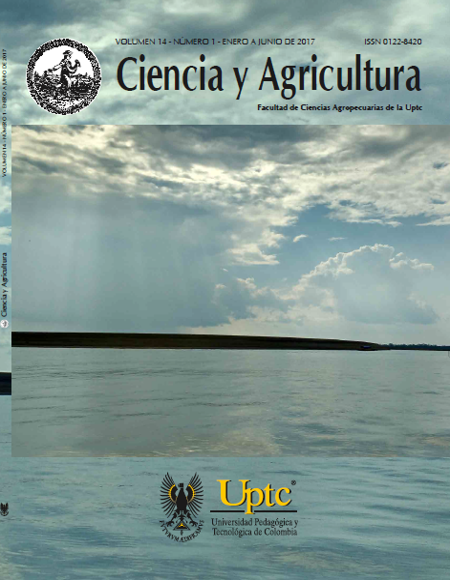In situ digestibility of corn stover’ treated with fibrolytic enzymes

Abstract
In situ digestibility of corn Stover fiber matrix treated with an enzymatic complex was studied by using two Swiss bulls (700 kg PV) with ruminant cannula. We used a randomized block design, where each animal constituted a block, and three enzyme levels: 0 g (TC), 1 g (T1), and 2 g (T2) of Fibrozyme® kg fodderl MS. The samples (5 g of dry matter in nylon bags) were incubated in the ruminant, and were extracted at 6, 12, 24, 48 and 72 hours after fermentation.
Debasement was analyzed by a none lineal regression, using the P=a+b* (1-e-c* (t-to)) model. The soluble portion of the fibrous matrix, determined by washing the bags, resulted similar in both fiber fractions (FDN and FDA), with values of 0.50, 0.59 and 0.68 % respectively for each treatment. The degradability values of the insolvent, but degradable, fraction were: 37.28, 36.64 and 37.30 % for FDN, and 33.85, 35.07 and 41.19 % for FDA, with their three respective treatments.
The T2 (FDN) and the TC (FDA) registered the highest degradation speed values (c %/h). The lag phase was approximately of 3.80, 4.90 and 4.80 h for FDN and 5.30, 5.30 and 4.90 h for FDA, with their three respective treatments. The FDN effective degradability (DE) oscillated between 19.70-14.40, 21.30-15.90 and 22.10-16.60 %; and the FDA, between 20.30-15.30, 21.10—15.80 and 23.40-17.30 %, in each one of the treatments, by using different ruminant exchange constants.
The corn stover showed good degradation potential, over 39 % in FDN and 44 % in FDA, when treated with the highest levels of fibrolytic enzymes (T2). The results showed that an optimal usage of the fiber-matrix as energy source for the animal can be achieved, when enzymatic complexes are used in agriculture products and residues such as corn stover through its ruminal fermentation.
Keywords
corn stover, fibrolytic enzymes, in situ digestibility, nutrients.
References
- Macedo RJ. Análisis del sistema de alimentación pecuario rastrojo de maíz (Zea mayz L.) – pasto estrella (Cynodon plectostachyus P.) en la zona norte del estado de Colima. Tesis de Doctorado, Facultad de Medicina Veterinaria y Zootecnia, Departamento de Posgrado Interinstitucional de Ciencia Pecuaria, Universidad de Colima. 2000.
- SAGARPA. Aprovechamiento de esquilmos y subproductos en la alimentación de ganado, 2009. [Consulta: 22 de octubre de 2013]. Disponible en: http://www.sagarpa.gob.mx/desarrolloRural/Documents/fichasaapt/Aprovechamiento%20de%20esquilmos.pdf.
- Coronel U, Ortega ME, Mendoza G, Sánchez MT, Ayala TJ, Becerril C. Effect of two strains of Saccharomyces cerevisiae on productive performance of heifers. Nutrition Society. 2001.
- Chalupa W. Chemical control of rumen microbial metabolism. In: Digestive Physiology and Metabolism in Ruminants. Ruckebush Y., and P. Thivend (eds). Proceedings of the 5th International Symposium on Ruminant Physiology. MTP Press Limited, Lancaster, England. 1979; 325-347. DOI: https://doi.org/10.1007/978-94-011-8067-2_16
- Feng P, Hunt CW, Pritchard GT, Julien WE. Effect of enzyme preparations on in situ and in vitro degradation and in vivo digestive characteristics of mature cool - season grass forage in beef steers. J. Anim. Sci. 1996; 74: 1349-1357. DOI: http://doi.org/10.2527/1996.7461349x. DOI: https://doi.org/10.2527/1996.7461349x
- Chen B. NEWAY EXCEL Version 5.0. A utility for processing data of feed degradability and in vitro gas production. Rowett Research Institute. Aberdeen, Scotland. 1997.
- García E. Modificaciones al sistema de clasificación climática de Köppen (para adaptarlo a las condiciones de la República Mexicana). Offset Larios S.A. México D.F. 1988, 46-52.
- Paterson RT, Quiroga L, Sauma G, Samur C. Crecimiento de novillas Cebú Criollo en la época de seca con acceso limitado a la Leucaena. Prod. Anim. Trop. 1983; 8: 150.
- McDonald IM. A revised model for the estimation of protein degradability in the rumen. J. Agric. Sci. 1981; 96(1): 251-252. DOI: http://doi.org/10.1017/s0021859600032081. DOI: https://doi.org/10.1017/S0021859600032081
- Ørskov ER, McDonald IM. The estimation of protein degradability in the rumen from incubation measurements weighted according to rate of passage. J. Agric. Sci. 1979; 92(2): 499-503. DOI: http://doi.org/10.1017/S0021859600063048. DOI: https://doi.org/10.1017/S0021859600063048
- Pedraza RM. Valoración nutritiva del follaje de Gliricidia sepium (Jacq.) kunth ex walp. y su efecto en el ambiente ruminal. Tesis Dr. Instituto de Ciencia Animal. La Habana, Cuba. 2000.
- AOAC. Official Methods of Analysis. 16th Ed. Ass. Off. Agric. Chem. Washington, DC. 1995.
- Van Soest PJ, Robertson JB, Lewis BA. Methods for dietary fiber, neutral detergent fiber, and nonstarch polysaccharides in relation to animal nutrition. J. Dairy Sci. 1991; 74(10): 3583-3597. DOI: http://doi.org/10.3168/jds.S0022-0302(91)78551-2. DOI: https://doi.org/10.3168/jds.S0022-0302(91)78551-2
- Bourguetts LL. Efecto del tratamiento alcalino sobre la cinética de degradación ruminal de dos subproductos lignocelulosicos. Tesis de Maestría. Centro Universitario de Ciencias Biológicas y Agropecuarias. División Ciencias Veterinarias. Universidad de Guadalajara, México. 1998.
- Elizondo EI. Evaluación de tratamientos alcalinos sobre la calidad nutricional de subproductos lignocelulósicos. Tesis de Doctorado. Facultad de Medicina Veterinaria y Zootecnia. Posgrado Interinstitucional en Ciencias Pecuarias Universidad de Colima, México. 1998.
- Estrada GT, Haro IM, Vázquez CRC, Martínez GDM, González DNT. Degradación in situ y patrones de fermentación del rastrojo de maíz (Zea mays L.) tratado con enzimas exógenas en vacas Holstein. Interciencia, 2015; 40(10): 716.
- Yescas R, Bárcena R, Mendoza G, González S, Cobos M, Ortega M. Digestibilidad in situ de dietas con rastrojo de maíz o paja de avena con enzimas fibrolíticas. Agrociencia, 2004; 38: 23-31.
- Salado EE, Comerón EA, Silva C, Gaggiotti MDC, Alesso A, Pardo J. Cascarilla de soja y afrechillo de trigo. Cinética de la degradabilidad ruminal de la fibra. Anuario EEA Rafaela. 2005.